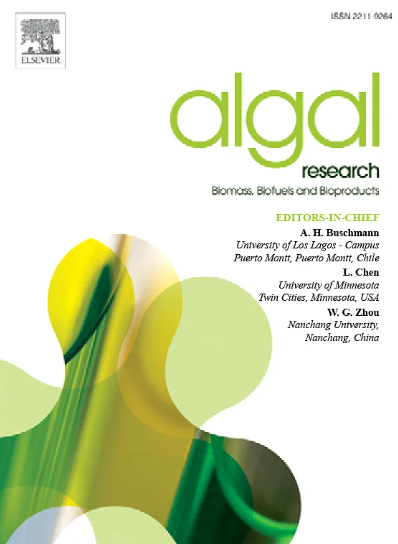Photoacclimation strategies in Phaeodactylum tricornutum biofilms
IF 4.6
2区 生物学
Q1 BIOTECHNOLOGY & APPLIED MICROBIOLOGY
Algal Research-Biomass Biofuels and Bioproducts
Pub Date : 2025-05-26
DOI:10.1016/j.algal.2025.104111
引用次数: 0
Abstract
Microalgal biofilms are a promising alternative to conventional suspended cultures, offering increased biomass densities with reduced water and energy demands for cultivation and harvesting. However, to fully demonstrate their interest for large-scale production, a better understanding of the impact of operational factors on biofilm structure is required. This study explores the effect of four different photon flux densities (75, 150, 300 and 600 μmol m−2 s−1) on Phaeodactylum tricornutum biofilms cultivated in a millifluidic system. For the first time, biofilm structure and physiology were characterised in situ, non-destructively by complementary imaging tools (Confocal Laser Scanning Microscopy, CLSM, and Optical Coherence Tomography, OCT) and dissolved oxygen measurements. Biofilms cultivated at 150 and 300 μmol m−2 s−1 presented the highest growth rates (0.31 and 0.38 d−1) while higher light intensities (600 μmol m−2 s−1) induced photoinhibition. On the other hand, biofilms at 75 μmol m−2 s−1 exhibited the lowest growth rate (0.23 d−1) but they were extremely efficient in converting absorbed light into biomass (2.5 times more efficient than the biofilms grown at 300 μmol m−2 s−1). Interestingly, adjustments in the optical properties of biofilms exposed to different light conditions were observed through changes in the light extinction coefficient with biofilms becoming more transparent when their thickness was higher than 200–300 μm. These findings reveal important photoacclimation strategies in P. tricornutum biofilms and highlight the potential of exploiting different light intensities and harvesting strategies to optimise the operation of biofilm-based processes.
三角褐指藻生物膜的光驯化策略
微藻生物膜是传统悬浮培养的一种很有前途的替代品,它提供了更高的生物量密度,同时减少了培养和收获的水和能源需求。然而,为了充分展示他们对大规模生产的兴趣,需要更好地了解操作因素对生物膜结构的影响。研究了四种不同光子通量密度(75、150、300和600 μmol m−2 s−1)对微流体系统中培养的三角褐指藻生物膜的影响。第一次,通过互补成像工具(共聚焦激光扫描显微镜,CLSM,光学相干断层扫描,OCT)和溶解氧测量,对生物膜的结构和生理进行了原位、非破坏性的表征。在150 μmol m−2 s−1和300 μmol m−2 s−1下培养的生物膜生长速率最高(0.31和0.38 d−1),较高的光强(600 μmol m−2 s−1)诱导光抑制。另一方面,75 μmol m−2 s−1条件下的生物膜的生长速率最低(0.23 d−1),但其将吸收的光转化为生物量的效率是300 μmol m−2 s−1条件下的生物膜的2.5倍。有趣的是,当生物膜的厚度大于200-300 μm时,通过光消系数的变化可以观察到不同光照条件下生物膜光学特性的变化。这些发现揭示了三角草生物膜的重要光驯化策略,并强调了利用不同光强和收获策略来优化生物膜过程操作的潜力。
本文章由计算机程序翻译,如有差异,请以英文原文为准。
求助全文
约1分钟内获得全文
求助全文
来源期刊

Algal Research-Biomass Biofuels and Bioproducts
BIOTECHNOLOGY & APPLIED MICROBIOLOGY-
CiteScore
9.40
自引率
7.80%
发文量
332
期刊介绍:
Algal Research is an international phycology journal covering all areas of emerging technologies in algae biology, biomass production, cultivation, harvesting, extraction, bioproducts, biorefinery, engineering, and econometrics. Algae is defined to include cyanobacteria, microalgae, and protists and symbionts of interest in biotechnology. The journal publishes original research and reviews for the following scope: algal biology, including but not exclusive to: phylogeny, biodiversity, molecular traits, metabolic regulation, and genetic engineering, algal cultivation, e.g. phototrophic systems, heterotrophic systems, and mixotrophic systems, algal harvesting and extraction systems, biotechnology to convert algal biomass and components into biofuels and bioproducts, e.g., nutraceuticals, pharmaceuticals, animal feed, plastics, etc. algal products and their economic assessment
 求助内容:
求助内容: 应助结果提醒方式:
应助结果提醒方式:


